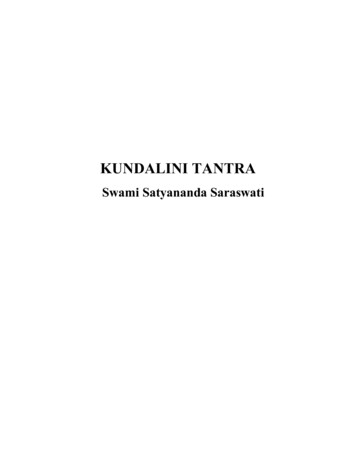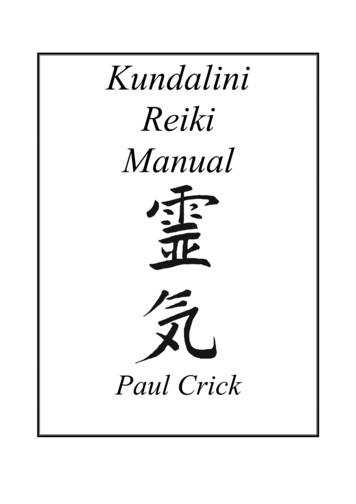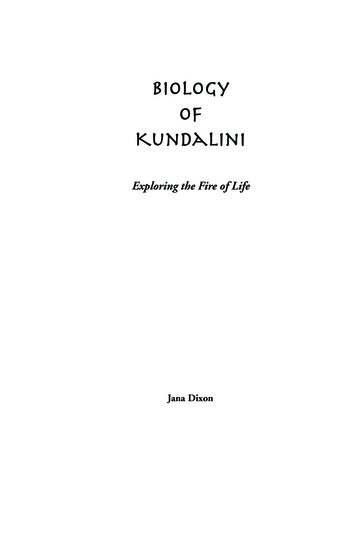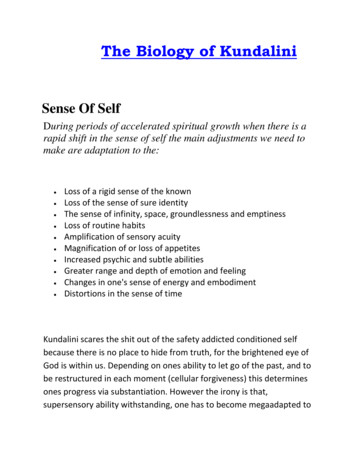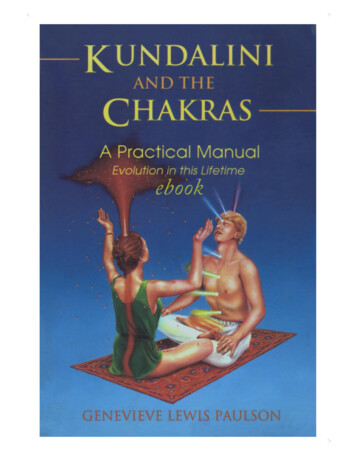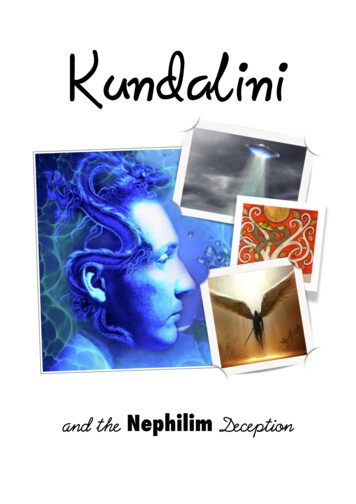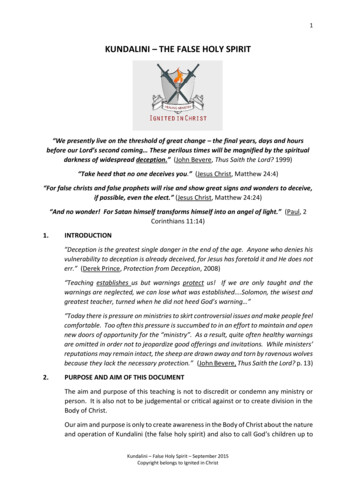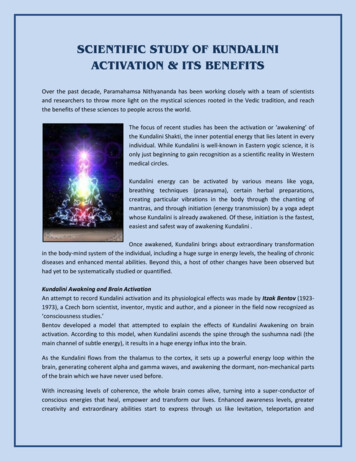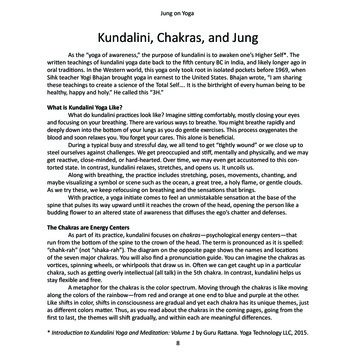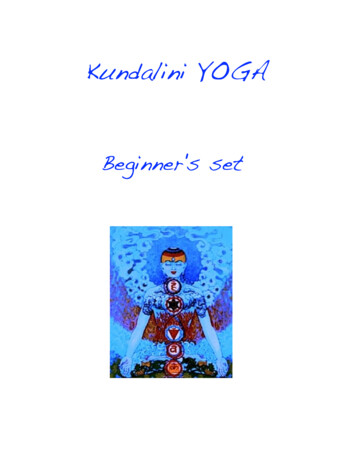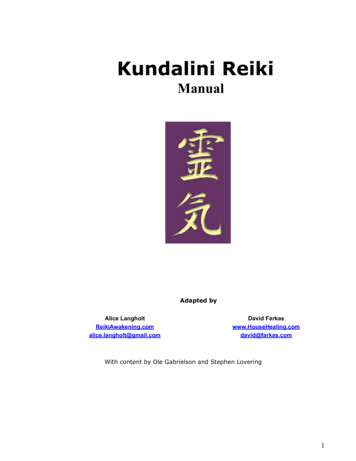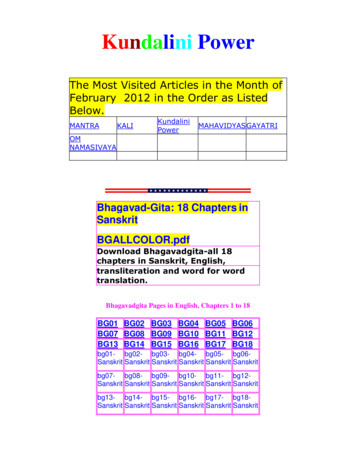
Transcription
Kundalini PowerThe Most Visited Articles in the Month ofFebruary 2012 in the Order as ListedBelow.MANTRAKALIKundaliniPowerMAHAVIDYAS GAYATRIOMNAMASIVAYABhagavad-Gita: 18 Chapters inSanskritBGALLCOLOR.pdfDownload Bhagavadgita-all 18chapters in Sanskrit, English,transliteration and word for wordtranslation.Bhagavadgita Pages in English, Chapters 1 to 18BG01 BG02 BG03 BG04 BG05 BG06BG07 BG08 BG09 BG10 BG11 BG12BG13 BG14 BG15 BG16 BG17 BG18bg01- bg02- bg03- bg04- bg05- bg06Sanskrit Sanskrit Sanskrit Sanskrit Sanskrit Sanskritbg07- bg08- bg09- bg10- bg11- bg12Sanskrit Sanskrit Sanskrit Sanskrit Sanskrit Sanskritbg13- bg14- bg15- bg16- bg17- bg18Sanskrit Sanskrit Sanskrit Sanskrit Sanskrit Sanskrit
HOME PAGEClick below for Magnum Opus of Purnananda-Svami (1526 CE) on Kundalini Yoga
Serpent PowerComplete.pdfThis file has the complete book of The Serpent Power plus illustrations by me with highlights ofpassages with the footnotes.Serpent Power is the English translation of Sat-Cakra-Nirupana (Six-Chakra Investigation) inSanskrit written byPurnananda-Svami (1526 CE). This PDF contains:1: THE SIX CENTRES AND THE SERPENT POWER (Kundalini)2: ṢAṬ-CAKRA-NIRŪPAṆA ( Six-Chakra Investigation)3: THE FIVEFOLD FOOTSTOOL (Pādukā-Pañcaka)4: Illustrations, Tables, and Highlights.By Veeraswamy KrishnarajSerpent Power Complete.pdf
Other enunciation is Lam (Bija letter) --Vamशं षं सं)Śam Ṣam Sam(वंfor Muladhara Chakra as the letters look.You may follow this convention of enunciation of alphabets for all other Chakrasalso. For chanting of Bija mantras and the letters,assume Lotus Position. The overdots above the Sanskrit letters indicate the Mterminator.
Fall into the Gap (Feb 4, 2009)There are aspirants who do not want to be bothered with any Mantras, Stotras,Karikas,Tantras, Yantras, Mental and Physical Gymnastics, Breath control, Yogaclasses and the like. Is there anything in the world that advocates and embracessimplicity? Yes, there is. This is where you fall into the Gap.You are a running stream of thoughts during awake and dream states. Betweenthoughts, there is a gap or silence. Between movements, there is a stationary gap.Between forward and backward movements as in a car there is a moment or gapwhen there is no movement. You have to find that gap. That gap is free ofthoughts. That is where tranquility, peace and Universal Consciousness reside.There is something between two thoughts; one calls it a Gap; another calls it aconnector. It is all semantics. Thoughts cannot rise or propagate in the mind lakewithout consciousness; without the latter, there is no life. This Gap, this UniversalConsciousness is Unmesa, opening of Spiritual eye or whatever you want to callit. It is the fount, the fountainhead, the origin, the Essence. This is where youabide in your tranquil moment.Once you find that Gap or Universal Consciousness, you hold on to it and stretchit or stay in it as long as you can. Your mind is blank; the mind-slate is clean; themind lake is tranquil; the mind dies figuratively-- Mana-NAsa; there are nothoughts; there is peace. In this cacophonic world, how is one going to find thisGap? The best time for finding this Gap or opening is between 4 AM and 7 AM.That is when you are most relaxed. You had the needed rest, sleep andregeneration. The birds are not chirping; the sirens are not wailing. The kids are inbed sleeping soundly. Stay in bed flat and supine. Keep your eyes closed withcurtains drawn the night before. Close your physical eyes; open your spiritualeyes; and focus them into distant space where there is no object to perceive todistract your attention. Turn off your Cerebral Mantle, the generator of thoughtwaves. It is not that difficult. Find that pristine silent thought-free gap. Hold on toit and stay in it as long as possible. Your breathing slows down. Your heart rategoes down. The Gap is the non-pharmacologic Beta Blocker that slows yourheart. You will live longer. The aspirant has to maintain a thoughtless state(Nirvikalpa) so that by grace of the Divine or the Force he gains entry intoUniversal Consciousness. You are in touch with your precious and pristine Self.That is your Essential Self. You don't have to look for the Force; when youremain free of thoughts, the Force will find you and embrace you. Your mind lakehas no waves. You dissolve in Universal Consciousness; you have becomeidentical with it; that is SamAvesa (identical guise with UniversalConsciousness). You overcame the thought barrier between your individual selfand the Universal Self. Universal Consciousness bathes your mind and preventsgeneration of thoughts. This is what Kashmir Saivism recommends as UpAya orthe ways and means to enter the world of Universal Consciousness. It is calledSambhavopAya. It is Sambhava or SamAvesa or absorption of individualconsciousness in the Divine Consciousness. Here there is no need for breathcontrol, Mudras, Bandhas, Meditation or Mantras. End of Gap.For the Hindus, the willing and the compliant, here are some suggestions for afuller life. When you get out of the bed, utter the name of Kesava (destroyer of
Kesin, Krishna) several times; this will set the day on a smooth path withoutobstructions, obstacles and frustrations. Its potency is equal to supplicating toGanesa with "Om Ganesaya namah." When you go to bed, you count sheepjumping over the fence as a sleep aid. The idea is that you concentrate so much onthe sheep that you forget the day's worries; counting eventually puts you to sleep.Mentally chanting Narayana upon going to bed - the Hindu way of counting sheep- and awakening brings benefits; the benefit of uttering the name in sleep thoughnot uttered comes to the devotee; that is the paradoxical Grace of Bhagavan.Utter the name of Govinda as many times as possible when you are aboutto eat. This will provide you your next meal and more thereafter. Consider manymishaps that could happen between meals that could prevent you from eating yournext meal. Here eating your next meal means that you are alive and well. January2010. Example: Think of the unfortunate earthquake victims in Haiti, who werehale and healthy and the next moment. I can't even think, fathom and narrate thehorror of their suffering. If you eat less or more, both are bad. In Hinduism, youdon't eat for yourself; you eat for the Atman, the Great Soul or the Universal Soulin you. Bhagavad Gita says:6.16: Yoga is not for him, who either eats too much, or eats too little. It is not forhim, who either sleeps too much or stays awake too long, O Arjuna.9.27: Whatever you do, whatever you eat, whatever offerings you make,whatever you give away, and whatever austerities you perform, O son of Kunti,do that offering unto Me.The Christian equivalent is saying the Grace before meals. All acts are done forHim, which means service to mankind is service to Him.Dear Lord, bless this food to the nourishment of our bodies and us to thyservice. In Christ's name we pray, Amen.The Jews have more elaborate recitation of Grace before (Ha-motzi), after,and between meals. They have Grace for wine, fruits, pastries, beverages, nonearth foods (meat, fish, milk and cheese). A typical Jewish Grace is as follows:Praised be Thou, O Lord (Adonai) our G-d (God), King of the universe whobrings BREAD from the earth or by whose word all things came into being.For each food item substitute the name of that food in the Grace: Fruit of the vine,fruit of the earth (vegetables), pastries.You may notice in the Jewish Grace that by God's word all things came intobeing. In Hinduism, God by His Will, thinks the Thinkables, utters theSpeakables, and creates the objects, Universe and beings. The Thinkable becomesthe Speakable and the Speakable becomes the Object. I think and speak Apple;Abracadabra! I have Apple on the palm of my hand; I wish it is that easy. It is byGod's thought and word, creation comes into being. SUta Samhita says, SupremeConsciousness is Motionless Apada (Stirless word or Brahman), which becomes
the four forms of Pada (word), which again can become Apada. That sound iscalled NADA by the Tantrics, which is the origin of beings and objects. WhenBindu explodes, a sound is produced which is called SabdaBrahman (SoundBrahman Sound Consciousness). Bindu is like a spontaneously explodingWisteria Seed Pod. A German homeowner called the police and took coverunder the table when he heard a barrage of gunshots outside the house in hisgarden. The police responded only to discover the seed-missiles wereshooting out of the exploding Wisteria pods.Sabdabrahman is Karana Bindu (Causal Bindu) which remains motionless(Nispanda) and that sound is called ParA VAk. When this stirless sound, thatremains in Muladhara Chakra, unites with the mind, assumes the nature of KaryaBindu (Action Bindu), exhibits vibration and motion and manifests as Pasyanti(Visual Sound) in Svadhistana and Manipura Chakras. This evolving and stirringSabdabraman (with the mind) moves to Anahata Heart Chakra, it acquiresBuddhi and NAda. (Buddhi understanding) Now the sound is calledMadhyama (middle stage) at the heart level. Anahata sounds heard by the yogisare chini, chini-chini (onomatopoetic sounds), the sound of bell, conch, lute,cymbals, flute, drum, Mridanga (double-drum), and the last thunder. These tenAnahata sounds can be heard at random subsequently and only during meditation.Ahata Sound as opposed to Anahata is the sound that is produced by an externalsound producer such as a drum and perceived by an anatomical sensory organsuch as ear. Anahata sounds originating in the spiritual heart are perceived by(the non-anatomical spiritual or) subtle ear. So far the sound is not audible by thethird person. The next development of the SoundBrahman is audible speech(Vaikhari or articulate speech) when it ascends to the voice box in VisuddhaChakra. At this level it acquires Spastatara (more evident, clear orintelligible). As you see, the stirless sound of ParAvAk acquires the faculties ofmind, Buddhi and NAda and eventually comes to a VirAt state (manifest state)and blossoms out in words, phrases, sentences, prose, poetry of all languages.ParAvAk is the Incubating Nidus or the Womb of discoveries and inventions.Yogakundali Upanishad says, the speech sprouts in ParA, springs leaves inPasyanti, buds in Madhyama and blossoms in Vaikhari. Speech is deified asGoddess who goes by the names UttIrnA (rise up) and Pasyanti.The ancient pre-Christian and pre-Judaic Hindu concept is the body is PINDAmade of food; not only you dedicate the body to serve Him but also and moreimportantly your soul to Him (Atma Samarpanam ஆத்மா சமர்ப்பணம் Soul dedication). In my humble opinion, there is nothing in this universe thatHindu religion has not fathomed which is present in other religions.Who doesn't like to hear the sweet nectarian sound of his name uttered bysomeone else? Among all names, Bhagavan likes to hear his devotees sayGovinda in couplets: Govinda Govinda.
In Judaism, out of due reverence for G-d (God), there is a prohibition on thepronunciation of four-letter name (YHVH Yod-Heh-Vav-Heh) except in prayeror study. The common practice is to mispronounce the name (politely andreverentially called deletion and substitution of syllables or letters) so Adonai ismispronounced as Adoshem; Elohaynu and Elohim are mispronounced asElokaynu and Elokim. (The Hindu Chanters of hymns of 1000 names of Vishnuhave a supreme adherence to the proper enunciation of names. Any intentionalmispronunciation is sacrilegious and prohibited. Tantrics are very particular aboutexact and precise pronunciation. When you invoke god or goddess, properenunciation is important. If the Hindu were to invoke and call god, JOHN SMITHas JOAN SMYTHE, both deities (John Smith and Joan Smythe) get angry withthe invoker; consequences may be serious or they may simply forgive himbecause they know his sincere devotion to both of them. In Hinduism,unintentional mispronunciation does not invite the wrath of God. Here is a quote,"Even if one were to slip on the proper method of reciting it (with faith andcompletely surrendered), the Thirumanthra will not slip from its nature, which isproviding full protection to those reciting it. The Thirumanthra will protecteveryone who recite it, no matter how they do it. That is, it never fails in itsnature." It is like mispronouncing the name of the medication and taking itinternally. The medication still works and brings about its intended effect, nomatter what you call it.Thirumanthra: Om namo Narayanaya.In Hinduism there is ONE GOD and many are His or Her names. Hindus believethat God is formless [Brahman] and One; people call Him or Her Brahman, TheLord, Allah, Adonai or any other name if a new Prophet, Messiah or Guru comesalong in the future and establishes a new religion entirely unknown andunimagined by us now. Consider the possibility that a new future prophet (Nuo)declares establishment of a new religion, NUOISM AND CALLS HIS GODNUON and declares that all other Gods are defunct pretenders. Nuon, Nuo, andNuoism become legitimate because 3 billion people converted to Nuoism. Now Iknow we should not be fighting with each other in the name of religion.) Inwriting the word G-d (God) in Judaism, an observant Jew drops the letter O. G-dis often referred to as Ha-Shem (The Name), the Ineffable Name, the UnutterableName or the Distinctive Name. To the Jew, God is One, both female and maleblended in One but He or She comes with many names and flavors. He invokesand thanks Lord Adonai for Her kindness; he invokes God Elohim for beingharsh (justice) on him. Simply, Feminine Lord Adonai becomes Masculine GodElohim depending upon dispensation. To him Female Lord (Lady) Adonai andMale God Elohim are parents--though one-- keeping the children in line first bygiving soft love and then some tough love. Hinduism also has an androgynousGod by name Ardhanarisvara (Ardha-Nara-Isvara half-man-Lord Right half isthe Lord a
Kundalini Power The Most Visited Articles in the Month of February 2012 in the Order as Listed Below. MANTRA KALI Kundalini Power MAHAVIDYAS GAYATRI OM NAMASIVAYA Bhagavad-Gita: 18 Chapters in Sanskrit BGALLCOLOR.pdf Download Bhagavadgita-all 18 chapters in Sanskrit, English, transliteration and word for word translation. Bhagavadgita Pages in English, Chapters 1 to 18 BG01
